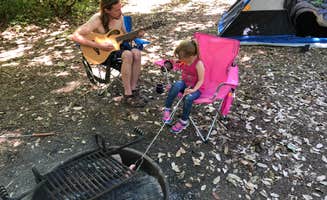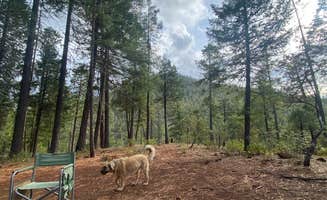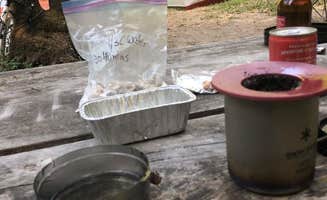Tent campsites near Glendale, Oregon provide wilderness experiences across a wide elevation range, from 1,500 feet in creek bottoms to 4,000 feet at viewpoints. Many sites remain accessible from late spring through early fall, though some lower-elevation locations can be reached year-round. The region's public lands fall primarily under Bureau of Land Management jurisdiction with limited facilities but abundant natural features.
What to do
**Creek exploration: Bring water shoes for Mule Creek near Tucker Flat, which offers excellent swimming spots during summer. "The campsites are up a steep hill from the lovely Mule Creek - a great place for wading and swimming in the crisp cool waters. Watch out for poison oak," notes reviewer Kelly P.
**Astronomy sessions: Nighttime stargazing opportunities are exceptional at higher elevations. At Onion Mountain, visibility extends to major celestial features due to minimal light pollution. "You are at 4000 feet and you can see the milky way clearly," shares one visitor.
**Winter camping: Several tent sites remain accessible during winter months, with some areas offering unique snow camping experiences. Visitors to Tin Can report, "Beautiful hiking trails throughout the area. We like to camp here especially in the snow!"
What campers like
Privacy at primitive sites: Most tent campers appreciate the solitude found at BLM sites throughout the region. Lower-traffic weekdays provide opportunities for complete seclusion at many locations.
Consistent water access: Creek-side camping offers reliable water sources for filtering drinking water or recreational use. Many sites position tent pads within short walking distance of year-round water sources.
Family-friendly areas: Some locations provide opportunities for multi-generational experiences. Big Pine Campground visitor Katie notes: "Been going here for years. Great family friendly fun and lots to do."
What you should know
Road conditions vary drastically: Forest roads accessing tent sites often require high-clearance vehicles or additional travel time. The drive to Tucker Flat exemplifies this challenge: "A two hour plus drive on rough, curvy road from Galice," according to one camper.
Limited facilities: Most BLM campsites provide no amenities beyond flat tent spaces. Where toilets exist, they are typically pit-style outhouses with seasonal maintenance schedules.
Seasonal fire restrictions: Fire regulations change throughout camping season, with complete bans common during late summer months. Check current fire status before planning cooking arrangements.
Hunting season impacts: October brings increased campsite competition during hunting season. Bear Camp Viewpoint and other accessible sites fill quickly during this period, requiring advance arrival to secure spots.
Tips for camping with families
Pack extra water supplies: With drinking water unavailable at most sites, family camping requires calculating 1-2 gallons per person per day plus additional reserves.
Plan shorter access routes: For camping with children, prioritize locations with shorter drive times on improved roads. Some viewpoint locations provide easier access than creek-bottom sites requiring lengthy forest road navigation.
Create site maps: Many primitive areas lack clearly defined boundaries between individual sites. Mark your chosen site boundaries with temporary indicators to help children understand camp limits.
Bring wildlife identification materials: BLM Wildcat Camp and similar locations provide opportunities for tracking and species observation during morning hours when animal activity increases.
Tips from RVers
Length restrictions matter: Forest roads to tent sites often prohibit trailers over 22 feet due to tight turns and steep grades. Scout locations before attempting access with any trailer.
Consider tent-only trips: Even RV owners sometimes prefer tent camping at these remote sites. BLM Big Windy Creek and similar locations provide experiences unavailable to larger rigs.
Bring backup systems: Tent sites lack hookups and often have no cell service. Solar charging systems, paper maps, and redundant supplies become essential when camping far from services.







